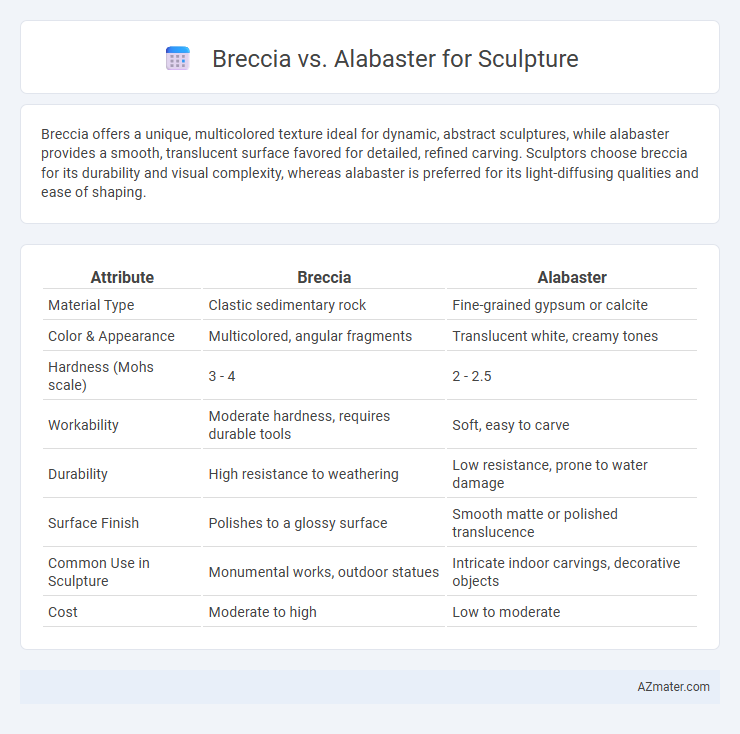Breccia offers a unique, multicolored texture ideal for dynamic, abstract sculptures, while alabaster provides a smooth, translucent surface favored for detailed, refined carving. Sculptors choose breccia for its durability and visual complexity, whereas alabaster is preferred for its light-diffusing qualities and ease of shaping.
Table of Comparison
| Attribute | Breccia | Alabaster |
|---|---|---|
| Material Type | Clastic sedimentary rock | Fine-grained gypsum or calcite |
| Color & Appearance | Multicolored, angular fragments | Translucent white, creamy tones |
| Hardness (Mohs scale) | 3 - 4 | 2 - 2.5 |
| Workability | Moderate hardness, requires durable tools | Soft, easy to carve |
| Durability | High resistance to weathering | Low resistance, prone to water damage |
| Surface Finish | Polishes to a glossy surface | Smooth matte or polished translucence |
| Common Use in Sculpture | Monumental works, outdoor statues | Intricate indoor carvings, decorative objects |
| Cost | Moderate to high | Low to moderate |
Introduction to Breccia and Alabaster
Breccia is a sedimentary rock composed of angular fragments cemented together, prized in sculpture for its striking patterns and vibrant colors, offering dynamic visual interest and durability. Alabaster, a soft, translucent mineral typically composed of gypsum or calcite, is valued for its smooth texture and ability to capture fine details, making it ideal for intricate carvings and delicate sculptures. Sculptors choose breccia for bold, textured works and alabaster for refined, detailed artistry due to their distinct physical properties and aesthetic appeal.
Geological Origins and Composition
Breccia is a sedimentary rock composed of angular fragments cemented together, typically formed through geological processes like faulting or volcanic activity, exhibiting a coarse, heterogeneous texture ideal for rugged, textured sculptures. Alabaster is a fine-grained, soft form of gypsum or calcite, originating from sedimentary evaporite deposits, characterized by its smooth, translucent surface, making it perfect for delicate, detailed carving. The distinct geological origins influence their durability and aesthetic qualities, with Breccia offering strength and varied coloration, while Alabaster allows for intricate designs due to its uniform softness.
Appearance and Color Variations
Breccia features a distinctive appearance with angular fragments of various colors embedded in a contrasting matrix, creating a bold, dynamic visual effect ideal for striking sculptures. Alabaster offers a smooth, translucent surface with soft, consistent hues ranging from white to cream, allowing for delicate, refined detailing in sculptural works. The contrasting textures and color variations between Breccia and Alabaster provide artists with versatile options for achieving either dramatic or subtle aesthetic outcomes.
Workability and Sculpting Techniques
Breccia offers excellent workability due to its coarse texture and hardness, making it ideal for detailed, durable sculptures that emphasize natural veining and color variations. Alabaster, softer and more translucent, allows for intricate carving and smooth finishes, often used for delicate, finely detailed sculptures. Sculptors prefer breccia for bold, robust forms while alabaster suits refined, elegant designs requiring subtle light diffusion.
Durability and Longevity
Breccia offers superior durability for sculpture due to its composite nature of angular fragments cemented together, making it more resistant to weathering and physical impact compared to alabaster. Alabaster, being a softer and more porous mineral, tends to be more susceptible to scratching, chipping, and deterioration over time, especially in outdoor environments. Sculptors seeking long-lasting, robust works often prefer breccia for its enhanced structural integrity and longevity in diverse conditions.
Historical Use in Sculpture
Breccia, historically prized for its dramatic contrast of angular fragments and vibrant colors, was extensively used in Roman and Byzantine sculptures and architectural decorations. Alabaster, favored by ancient Egyptians and Mesopotamians, offered a smooth, translucent surface ideal for detailed carving and religious artifacts. Both materials highlight distinct artistic traditions: breccia emphasizing texture and color variation, alabaster showcasing fine, intricate workmanship.
Cost and Availability
Breccia is generally more expensive than alabaster due to its geological rarity and the complex quarrying process involved. Alabaster is widely available and affordable, making it a popular choice for sculptors seeking an economical option without sacrificing aesthetic appeal. Sculptors must balance budget constraints with the desired durability and finish, as breccia offers a polished, vibrant look at a higher cost, while alabaster provides softness and ease of carving at a lower price point.
Maintenance and Preservation
Breccia, a composite rock made of angular fragments cemented together, requires careful sealing to prevent moisture infiltration and preserve its structural integrity, as it is prone to weathering and staining. Alabaster, a softer and more porous mineral, demands gentle cleaning with non-abrasive materials and consistent environmental control to avoid surface erosion and discoloration caused by humidity and light exposure. Both materials benefit from controlled display conditions and regular inspections to maintain the sculpture's aesthetic and longevity.
Notable Sculptures and Artists
Breccia and alabaster have both been prominent materials in sculpture, with breccia favored for its striking, multicolored stone seen in notable works such as Michelangelo's unfinished sculptures, where its durability complements detailed carving. Alabaster, prized for its translucency and smooth texture, was extensively used by Renaissance artists like Donatello, especially in delicate portrait busts and religious figures. Renowned sculptors often selected breccia for monumental, robust pieces, while alabaster was preferred for intricate, luminous works, highlighting the distinctive qualities of each stone in artistic expression.
Choosing the Right Stone for Your Sculpture
Breccia offers a unique, multicolored appearance with its angular fragments cemented together, providing dynamic visual texture ideal for bold, modern sculptures, while alabaster is prized for its smooth, translucent quality that allows light to softly diffuse through, perfect for delicate and detailed carvings. When choosing the right stone for your sculpture, consider breccia for durability and striking color patterns that enhance large-scale or outdoor installations; alabaster suits indoor settings where fine detail and gentle luminosity are desired. Evaluating factors like hardness, workability, and final display environment ensures the selected material complements your artistic vision and practical needs.

Infographic: Breccia vs Alabaster for Sculpture
 azmater.com
azmater.com